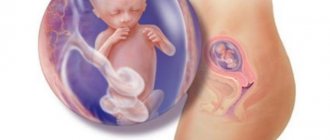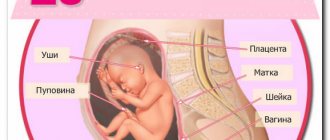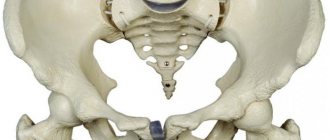The birth of a child is deservedly called a real miracle, and most future parents want to find out the gender of the baby in advance in order to properly prepare and change their own lives depending on who exactly is to be born - a boy or a girl. This can be determined using a standard ultrasound examination. Today it still remains the safest, most informative and widely used diagnostic method. How does an ultrasound examination of a boy differ from an examination of a girl?
Formation of fetal sex
Sex is determined at the moment of conception, when the egg and sperm meet. An egg always has an X chromosome, but a sperm can have both a Y and an X. The combination of XY chromosomes means a boy, XX a girl.
At the 6th week, the genital tubercle forms, so far it is similar in boys and girls. On the 7th–8th, sex hormones begin to act and the external genitalia are formed, and the sexual orientation of the brain is determined.
With the eleventh, you can see the differences - the tubercle begins to differentiate. The development of the genital organs occurs until the 7th–8th month of pregnancy.
3D ultrasound at 22 weeks
Modern technologies also make it possible to do 3D and 4D ultrasound. Such a study is of higher quality, because it allows you to see a three-dimensional image of the fetus and how it moves in real time. Also, such an image will allow for a more accurate diagnosis.
You can preliminarily agree on a computer recording of what is happening on the monitor screen - after the study they will give you a disk with the recording, and then you will be able to view what your baby was like before he was born.
How does the procedure work?
During the first ultrasound, a transvaginal probe is used, over which a disposable condom is placed, and the probe is inserted into the vagina.
The second and third ultrasounds are performed transabdominally - first, a special gel is applied so that there is no distortion of the ultrasound waves, and the sensor is moved over the abdomen. During the procedure, the sound is turned on for a few seconds to assess the fetal heartbeat. On average, everything lasts 10 minutes; if the parents wish, you can take a photo.
You can ask that dad also be present at the ultrasound, preferably at the second or third, because the baby is better visible.
It is necessary to watch an ultrasound to determine the sex of the child:
How do they do it?
The procedure itself is simple for a woman and does not pose any danger.
There is no need to prepare specially for it - the amount of amniotic fluid is enough for the ultrasound signals to “reach” the baby.
To conduct the study, the woman must lie down on the couch. The doctor lubricates the patient’s stomach with a special gel and places a sensor on it.
Depending on which area to look at, he moves it. He can tell his mother what exactly he is examining and what condition this organ is in.
Differences between boys and girls on ultrasound
The sex can first be seen at 11–13 weeks. Experts know how to distinguish a boy from a girl using an ultrasound, even at such a short time.
To determine the sex of a child by ultrasound in the early stages, indirect signs are examined. At 12 weeks, you can see the first differences - in boys there will be a linear formation in the middle on the genital tubercle, and in girls 4 parallel lines are visible. The linear formation in boys is the future scrotum and penis, and the 4 parallel lines in girls are the future labia.
The angle between the genital tubercle and the child’s body is also different - if the angle is less than 30°, then it is a girl, if more, then it is a boy.
What the developing penis and scrotum look like can be seen at the 15th week - the tubercle looks like a snail. From the thirteenth, the foreskin develops. At 19–20 weeks, the penis and scrotum are clearly visible. Boys' testicles are still in the abdomen, descending into the scrotum from the 32nd week.
In girls, from 16 and 17 weeks, the labia minora develop, and a little later - the labia majora. From the twentieth, the clitoris is formed.
When is the best time to go for an ultrasound to see the gender of the baby?
During registration with a doctor in the antenatal clinic, a pregnant woman is sent for the first ultrasound, which is usually performed at 12 weeks. This period is important for the reason that it is during this period that the presence of various pathologies in the fetus can already be detected. At the same time, you can try and determine the sex of the baby if he does not turn away or cover himself with his arms and legs.
But you need to take into account that the percentage of errors is very high, so the gender of the child as a result may differ from the predicted one. To accurately determine the sex of a boy or girl, an ultrasound should be performed at the fourteenth week of pregnancy . During this period, errors become minimal, since not only the external genitalia are considered, but the angle between the baby’s back and his genital tubercle is measured.
Depending on this indicator, the specialist will name the gender of the unborn child. If a woman still doubts the readings of the instruments and wants to check again, she can again see what the baby looks like at the eighteenth week of pregnancy. At this stage, the genitals are already developed to such an extent that there can no longer be an error in the determination.
What mistakes can be made
First of all, a lot depends on the quality of the device; if the picture is blurry, it will be difficult for even an experienced doctor to see something.
Most often, mistakes are made when identifying a boy, because a loop of the umbilical cord or a child’s finger can be mistaken for a penis. If the doctor identifies a girl, there is less chance of error.
It is very difficult to determine the sex too early, unless you can try to measure the angle. In the 3rd trimester, the baby is already large, cannot turn freely, if he turns away from the sensor or covers his groin with his hands, determining the sex may be difficult.
Probability of getting an erroneous result
Many parents are interested in whether there is any possibility of erroneous determination of the baby’s gender. Usually, unreliable information is obtained if an ultrasound is performed at a short stage of pregnancy. A qualified doctor can determine the sex of the fetus as early as 15 weeks, but at this stage mistakes are quite common. The most accurate result can be obtained from an examination carried out between 18-25 weeks of pregnancy.
At a later stage, the child may take a body position in which it is not possible to determine his gender. However, there are often cases when a woman from the 20th week of pregnancy was sure that she was carrying a boy, but gave birth to a healthy girl, and vice versa.
The accuracy of the result depends on the following factors:
- Modern equipment for ultrasound diagnostics. The most accurate results are provided by medical equipment with a three-dimensional projection. Since the projection of the child occurs in three planes at once.
- Fetal position at the time of examination. There are often cases when the baby is “shy” and at the time of the examination turns in such a way that his gender differences become invisible. In this case, the determination may not occur the first time;
- The amount of amniotic fluid.
- The qualifications and experience of the doctor conducting the study. In this case, usually inexperienced specialists mistake the baby's hand for the boy's penis.
However, it is necessary to understand that gender determination has a rather high error. There are cases that the gender of the child during the study may change from what was said earlier. At the 14th week of pregnancy, the likelihood of obtaining an incorrect result is minimized, since at this time you can not only examine the baby’s genitals, but also measure the angle between the genital tubercle and its back. Depending on the result obtained, the specialist can guess the gender of the baby. From the 18th week this error is reduced to a minimum.
Where is the best place to do it?
An ultrasound can be done at your antenatal clinic, where you are registered. This is a planned procedure, prescribed 3 times during the entire pregnancy, free of charge.
If desired, this can be done in a private clinic, especially if your consultation does not take photographs, does not allow the father to be present, or there are doubts about the results of the study. It is important to understand that the safety of ultrasound has only been proven at this stage of medical development, and you should not do more research than necessary.
Share the article, leave comments. Tell us how you first found out the sex of your baby. All the best.
Decoding and indicators of the norm
This is the most interesting and exciting thing for parents - whether their baby’s development corresponds to the norm.
Fetometry standards are as follows:
- Height at 22 weeks is about 25-30 cm, weight is approximately 450 grams, the brain makes up 25% of the child’s weight. If the pregnancy is multiple, the children will be smaller.
- Head circumference - 200 mm, tummy - 150 mm, length of legs and thighs - about 4 cm, forearms - 3.5 cm.
- The length of the cervix is more than 30 mm, closed on both sides.
- The volume of amniotic fluid is about 250 mm.
- The placenta has 3 vessels - 2 arteries and 1 vein, its thickness is from 18 to 30 mm, zero maturity.
They also describe the presence or absence of fetal malformations and determine the gender of the child. If the pregnancy is multiple, the same is determined for each child.
Fetus at 12 weeks of gestation
The child continues to develop, his head gradually straightens. The chin rises from the chest and becomes straight. The fruit is 6–7 cm long and weighs 10–13 grams. Leukocytes appear in the blood, the pituitary gland begins to produce hormones that affect metabolic processes and fetal growth. The thymus gland, which is responsible for the formation of the immune system, is also formed.
The development of the nervous system continues. A relationship appears between the brain and spinal cord. While the fetus is making aimless chaotic movements (the brain will control the body a little later). The baby can close and open his mouth, roll over, close his eyes, move his eyes and fingers, suck a finger, push away from the walls of the uterine cavity and swallow amniotic fluid, which then comes out along with urine.
The internal organs and systems of the fetus become more mature: the intestines have mastered peristalsis, the liver begins to produce bile, and the genitals have formed. The first hairs are visible on the baby’s body, and small nails are visible on the fingers. Bone substance is formed in the cartilaginous skeleton. The bladder and kidneys are actively functioning. The fetus urinates, and amniotic fluid is renewed hourly.
Facial features become more distinct. The ears, which are located on the neck, move to the side of the head. The inner ear develops, allowing the baby to hear vibrations.
Ultrasound as a method for diagnosing the sex of a child
Today, the most accurate method for determining the sex of the fetus is ultrasound. Until the 8th week of pregnancy, equal levels of testosterone production occur in both male and female infants. Next, the expectant mother, pregnant with a boy, experiences greater synthesis of the hormone. Under its influence, testicles are formed, which produce dehydrotestosterone, which affects the size of the sexual organ in the future.
Also, androgens are responsible for the signs of fetal gender, which form the difference between girls and boys. If their activity is insufficient, a girl is born. Already at 2 months of pregnancy, the genital organs of the fetus develop.
Sexual characteristics of the fetus
An ultrasound of a boy shows the following gender characteristics:
- formation of the penis has occurred;
- the scrotum is already fully formed;
- in the 2nd trimester of intrauterine development, the testicles descended into the scrotum;
- The baby's foreskin is formed.
Is ultrasound often mistaken about the gender of the child?
The girl has the following gender differences:
- during ultrasound diagnostics, the doctor identifies the testicles;
- the presence of the urethra is visible;
- the formation of the labia minora and majora occurred;
- the clitoris is visible.
There are significant differences between male and female infants. They are clearly visible during ultrasound examination. A boy's ultrasound shows the following external manifestations: boys have a bulge between their legs. This is the penis, the scrotum. Male babies have a reproductive system similar to the shape of a snail. Their placenta is located on the right side of the uterus. The skull and jaws are square in shape, and there is an angle of 30 degrees between the boy’s back and genitals.
Female infants have less testosterone in their blood than male infants. Due to this, girls are seen on ultrasound as follows:
- the genital bulge develops into the clitoris, clearly visible on examination. Moreover, the clitoris continues to form when the girl is already born;
- from the genital tubercles the formation of the external labia occurred;
- there is a pronounced groove of the genitourinary system;
- the vaginal opening is visible;
- the placenta with the girl is located on the left side of the uterus;
- the skull and jaws are rounded;
- An angle of less than 30 degrees is visible between the back and reproductive system.
The data obtained does not always coincide with reality
What does the belly look like at 12 weeks pregnant?
Video: 12th week of pregnancy
Attention!
This article is posted for informational purposes only and under no circumstances constitutes scientific material or medical advice and should not serve as a substitute for an in-person consultation with a professional physician.
For diagnostics, diagnosis and treatment, contact qualified doctors! Number of reads: 2182 Date of publication: November 28, 2017
Gynecologists - search service and appointment with gynecologists in Moscow
Why do you need an ultrasound
Examination of the baby before his birth is an important stage in preparation for his birth. If the child has pathologies, treatment may be carried out during pregnancy. In the case of operable defects, ultrasound helps to identify the problem in advance and prepare all the necessary help for the child. The need for an ultrasound is as follows:
- Ultrasound is harmless for the child, but very useful for the doctor. The study provides complete information about the state of health of the fetus and allows you to see possible deviations in the development of the child in the early stages. An ultrasound shows the condition of the placenta and umbilical cord, which allows us to judge whether the fetus is receiving nutrition and oxygen from the mother. Lack of vitamins and minerals, past infections, hereditary diseases, severe stress and many other factors can cause fetal development abnormalities. In some cases, if developmental abnormalities are detected, the doctor recommends termination of pregnancy.
- An ultrasound helps determine the presence of pregnancy in the uterine cavity, see the formation of organs, and the heartbeat. In practice, the discrepancy between actual and gynecological weeks ranges from 4-5 days to 20. The average discrepancy is 2 weeks. Actual weeks are counted from the moment the fertilized egg is fixed in the uterus, gynecological weeks are counted from the last menstruation. It is during an ultrasound scan at the 12th week that the doctor determines the date of birth and the degree of correspondence between the development of the fetus and the placenta, the place of attachment of the placenta and the degree of its maturity.
At a later stage, during the examination, the presence of umbilical cord entanglement, fetal presentation before birth, uterine tone, the likelihood of premature birth and even the baby’s body weight at birth are determined. This data will help you prepare as correctly as possible for childbirth.
Based on research data, the doctor decides on the possibility of spontaneous childbirth or the need for a cesarean section.
At 12 weeks, it is already determined that the child has external abnormalities indicating chromosomal abnormalities. The results of such an ultrasound are not a death sentence, but a prerequisite for additional research, indicating only an increased risk of abnormalities. Only after additional research is a final diagnosis made. To check, blood is donated for screening. In rare cases, chorionic villus analysis is performed, and at a later date, amniotic fluid. In case of serious deviations, parents can exercise the right to terminate the pregnancy for medical reasons.











